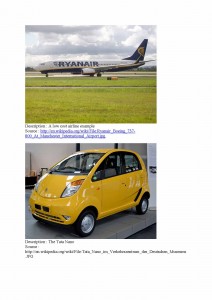By Milena Klasing-Chen
Low cost airlines, hard discounters, Dacia Logan, … These are just some examples of the great number of low cost products and services that have emerged over the years. These products often challenge incumbent companies when they enter their market, because their lower prices (achieved through cost reductions) tend to attract the more price-sensitive customers. [1]
But low cost products are not only products that had their cost reduced. Some cost reduction approaches, like delocalizing in countries with cheaper resources, do not make a product low cost. According to a recently published book on the subject [2], low cost products not only achieve significant cost reductions, but redefine the customer needs and create simplified offers (no-frills offers) to respond to these needs. Some of these have been thoroughly discussed in strategic management literature or in the literature of a specific domain, like low cost airlines [3], [4].
However, all the so-called low cost products do not follow the model applied to the low cost airlines, there are essential differences in the way low cost products can be designed. Comparing low cost airlines to frugal innovation [5] and to jugaad innovation [6] highlights different approaches to the question.
This article will describe some examples of successful low cost products (one that was cited recurrently in literature and two that are cited due to their innovativeness) and will give some perspectives of the use of low cost in innovative design.
Three distinctive experiences of low cost-driven products
Low cost airlines
The main change between a low cost and an incumbent carrier lies in their business model. Low cost airlines’ lower costs are based on several different aspects (point-to-point flights, use of secondary airports, different work contract, fleet homogeneity, direct or online booking…), and the lower price achieved by them is furthermore supported by ancillary revenues (ex: charging for meals, luggage or speed boarding…) [7].
The main principle is to remove all non-essential functions (like serving meals, offering a free newspaper) and several activities are transferred to the customer.
The Tata Nano
The Tata Nano does not correspond to the dominant design of cars. Not only are some essential visible features not present (there is only a rear mirror on one side), but the technology and operating system are also different (the car is rear-wheel driven and the two-cylinder engine resembles more to a motorcycle than to a car engine. [8]
The brief to design the Tata Nano was to find a way to transport four people in all weathers in a safe way, on four wheels, for about 2000 US dollars, to replace motorcycles. This ‘car’ has clear advantages over other cars besides its price, since it is narrower and smaller, allowing parking and passing easier in Indian cities, and that its’ fuel consumption is smaller. It is clearly safer and more adapted to all weathers than a motorcycle, but not as a classical car.
This product, not only removed functions, like in the case of low cost airlines, but also added other important functions for the customers. And not only did it change the business model, it also changed technical systems, functions and increased customer value.
Embrace – a low cost incubator
Embrace is a very atypical low cost incubator, designed to avoid hypothermia in newborns. It looks like a small blue sleeping bag, and works with a very different principle than classical incubators. The child’s temperature is kept constant for up to 6 hours through a phase-change material. This also means that there is no need to have constant electrical power. [6]
This incubator not only costs only a fraction of a classical incubator, but is has a much simpler operation: it only has an “ok/not ok” light, which means non-trained personnel can operate the device. In rural areas where access to nurses and doctors is difficult, and where achat viagra internet france power supply is not constant, this device has clear advantages. It also allows a closer contact between the infant and the parents, since these can still hold their child.
This product, although it has a lower cost, clearly has a higher utility for the customers. The customers however, are not the same as the ones for a classical incubator, that fulfills other functions than just keeping the infant’s body temperature. Instead of aiming medical personnel and hospitals, this product aims the parents.
Like the Tata Nano this product changed the business model, the technical paradigm, the functions and improved client utility: it’s fully renewing the object’s identity.
Designing low cost products and services
The analysis of these and other low cost products allows distinguishing between two main design models, ‘low cost adaptation’ and ‘smart low cost design’ [9]. The first strategy starts from an existing product and removes non-essential functions, doing a maximal cost reduction for a minimal client utility reduction. The second one starts from the desired function by the customer and a cost goal, and tries to design a product that would fit both, having the highest possible client utility.
Both models demand a clear definition of the product’s main function, to avoid removing functions that add high utility for the client. They also stress the importance of looking at creating low cost products as a design question, and not only a production and operational efficiency question. The use of these two models allows a more structured approach to low cost, since reducing costs stops being only a general goal for the company, but can be stated as a design model.
Another point that can be highlighted through the different examples is the important impact these products can have on their ecosystems and markets. In the case of low cost airlines, the development of the airlines was deeply linked to the development of secondary airports and their accesses. The saturation of existing secondary airports has been cited as one of the limitations to the low cost carriers expansion [10].
In the case of the Embrace incubator, the clients were different than those for the classical incubators, which demanded a different structure to distribute the product, as well as some interactions with the customers to better define their utility.
These questions are currently being studied at the chair “Design Theory and Methods for Innovation”, through a partnership with RATP, a French public transport operator, on low cost innovation in public transport to explore the design of low cost products as well as their markets and ecosystems.
References
[1] Kumar, N., 2006. Strategies to fight low-cost rivals. Harvard Business Review, December, 104 – 112.
[2] Combe, E., 2011. Le low cost. La Découverte.
[3] Pate, J. & Beaumont, P., 2006. The European Low Cost Airline Industry: The Interplay of Business Strategy and Human Resources. European Management Journal, 24, 322-329.
[4] Gillen, D. & Lall, A., 2004. Competitive advantage of low-cost carriers: some implications for airports. Journal of Air Transport Management, 10, 41 – 50.
[5] Rao, B. C., 2013. How disruptive is frugal? Technology in Society, 35, 65 – 73.
[6] Radjou, N.; Prabhu, J. & Ahuja, S., 2012. Jugaad Innovation: Think Frugal, Be Flexible, Generate Breakthrough Growth. John Wiley & Sons.
[7] Hunter, L., 2006. Low Cost Airlines: Business Model and Employment Relations. European Management Journal, 24, 315 – 321
[8] Ray, S. & Ray, P. K., 2011. Product innovation for the people’s car in an emerging economy. Technovation, 31, 216 – 227.
[9] Klasing Chen, M., 2013. The two models behind low cost products. 20th International Product Development Management Conference. Paris, France.
[10] de Wit, J. G. & Zuidberg, J., 2012. The growth limits of the low cost carrier model. Journal of Air Transport Management, 21, 17 – 23.

